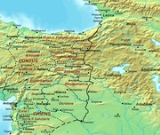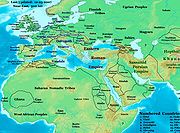
Anastasian War
Encyclopedia
The Anastasian War was fought from 502
to 506
between the Eastern Roman Empire
and the Sassanid Empire
. It was the first major conflict between the two powers since 440, and would be the prelude to a long series of destructive conflicts between the two empires over the next century.
and the Sassanid Empire
ever enjoyed. The Persian king Kavadh I
needed money to pay his debts to the Hephthalites who had helped him regain his throne in 498/499. The situation was exacerbated by recent changes in the flow of the Tigris
in lower Mesopotamia, sparking famines and flood. When the Roman emperor Anastasius I
refused to provide any help, Kavadh tried to gain the money by force.
through the autumn and winter (502-503). The siege of the city proved to be a far more difficult enterprise than Kavadh expected; the defenders, although unsupported by troops, repelled the Persian assaults for three months before they were finally beaten. The year 503 saw much warfare without decisive results: the Romans attempted an ultimately unsuccessful siege of the Persian-held Amida while Kavadh invaded Osroene
, and laid siege to Edessa
with the same results.
 Finally in 504, the Romans gained the upper hand with the renewed investment
Finally in 504, the Romans gained the upper hand with the renewed investment
of Amida leading to the hand-over of the city. That year, an armistice was agreed as a result of an invasion of Armenia by the Huns from the Caucasus. Negotiations between the two powers took place, but such was the distrust that in 506 the Romans, suspecting treachery, seized the Persian officials; once released, the Persians preferred to stay in Nisibis
. In November 506, a treaty was finally agreed, but little is known of what the terms of the treaty were. Procopius
states that peace was agreed for seven years, and it is likely that some payments were made to the Persians.
. The dilapidated fortifications were also upgraded at Edessa, Batnae and Amida.
Although no further large-scale conflict took place during Anastasius's reign, tensions continued, especially while work continued at Dara. This construction project was to become a key component of the Roman defenses, and also a lasting source of controversy with the Persians, who complained that its construction violated the treaty agreed in 422, by which both empires had agreed not to establish new fortifications in the frontier zone. Anastasius, however, pursued the project, deflecting Kavadh's complaints with money. The Persians were in any case unable to stop the work, and the walls were completed by 507/508.
502
Year 502 was a common year starting on Tuesday of the Julian calendar. At the time, it was known as the Year of the Consulship of Avienus and Probus...
to 506
506
Year 506 was a common year starting on Sunday of the Julian calendar. At the time, it was known as the Year of the Consulship of Messala and Dagalaiphus...
between the Eastern Roman Empire
Byzantine Empire
The Byzantine Empire was the Eastern Roman Empire during the periods of Late Antiquity and the Middle Ages, centred on the capital of Constantinople. Known simply as the Roman Empire or Romania to its inhabitants and neighbours, the Empire was the direct continuation of the Ancient Roman State...
and the Sassanid Empire
Sassanid Empire
The Sassanid Empire , known to its inhabitants as Ērānshahr and Ērān in Middle Persian and resulting in the New Persian terms Iranshahr and Iran , was the last pre-Islamic Persian Empire, ruled by the Sasanian Dynasty from 224 to 651...
. It was the first major conflict between the two powers since 440, and would be the prelude to a long series of destructive conflicts between the two empires over the next century.
Prelude
Several factors underlay the termination of the longest period of peace the Eastern RomanByzantine Empire
The Byzantine Empire was the Eastern Roman Empire during the periods of Late Antiquity and the Middle Ages, centred on the capital of Constantinople. Known simply as the Roman Empire or Romania to its inhabitants and neighbours, the Empire was the direct continuation of the Ancient Roman State...
and the Sassanid Empire
Sassanid Empire
The Sassanid Empire , known to its inhabitants as Ērānshahr and Ērān in Middle Persian and resulting in the New Persian terms Iranshahr and Iran , was the last pre-Islamic Persian Empire, ruled by the Sasanian Dynasty from 224 to 651...
ever enjoyed. The Persian king Kavadh I
Kavadh I
Kavad or Kavadh I was the son of Peroz I and the nineteenth Sassanid king of Persia, reigning from 488 to 531...
needed money to pay his debts to the Hephthalites who had helped him regain his throne in 498/499. The situation was exacerbated by recent changes in the flow of the Tigris
Tigris
The Tigris River is the eastern member of the two great rivers that define Mesopotamia, the other being the Euphrates. The river flows south from the mountains of southeastern Turkey through Iraq.-Geography:...
in lower Mesopotamia, sparking famines and flood. When the Roman emperor Anastasius I
Anastasius I (emperor)
Anastasius I was Byzantine Emperor from 491 to 518. During his reign the Roman eastern frontier underwent extensive re-fortification, including the construction of Dara, a stronghold intended to counter the Persian fortress of Nisibis....
refused to provide any help, Kavadh tried to gain the money by force.
War
In 502, Kavadh quickly captured the unprepared city of Theodosiopolis, perhaps with local support; the city was in any case undefended by troops and weakly fortified. Theodosiopolis was soon retaken by the Romans, but Kavadh then besieged the fortress-city of AmidaAmida (Roman city)
Amida was an ancient city located where modern Diyarbakır, Turkey. The Roman writers Ammianus Marcellinus and Procopius consider it a city of Mesopotamia, but it may be more properly viewed as belonging to Armenia Major....
through the autumn and winter (502-503). The siege of the city proved to be a far more difficult enterprise than Kavadh expected; the defenders, although unsupported by troops, repelled the Persian assaults for three months before they were finally beaten. The year 503 saw much warfare without decisive results: the Romans attempted an ultimately unsuccessful siege of the Persian-held Amida while Kavadh invaded Osroene
Osroene
Osroene, also spelled Osrohene and Osrhoene and sometimes known by the name of its capital city, Edessa , was a historic Syriac kingdom located in Mesopotamia, which enjoyed semi-autonomy to complete independence from the years of 132 BC to AD 244.It was a Syriac-speaking kingdom.Osroene, or...
, and laid siege to Edessa
Edessa, Mesopotamia
Edessa is the Greek name of an Aramaic town in northern Mesopotamia, as refounded by Seleucus I Nicator. For the modern history of the city, see Şanlıurfa.-Names:...
with the same results.

Investment (military)
Investment is the military tactic of surrounding an enemy fort with armed forces to prevent entry or escape.A circumvallation is a line of fortifications, built by the attackers around the besieged fortification facing towards the enemy fort...
of Amida leading to the hand-over of the city. That year, an armistice was agreed as a result of an invasion of Armenia by the Huns from the Caucasus. Negotiations between the two powers took place, but such was the distrust that in 506 the Romans, suspecting treachery, seized the Persian officials; once released, the Persians preferred to stay in Nisibis
Nisibis
Nusaybin Nisêbîn) is a city in Mardin Province, Turkey, populated mainly by Kurds. Earlier Arameans, Arabs, and Armenians lived in the city. The population of the city is 83,832 as of 2009.-Ancient Period:...
. In November 506, a treaty was finally agreed, but little is known of what the terms of the treaty were. Procopius
Procopius
Procopius of Caesarea was a prominent Byzantine scholar from Palestine. Accompanying the general Belisarius in the wars of the Emperor Justinian I, he became the principal historian of the 6th century, writing the Wars of Justinian, the Buildings of Justinian and the celebrated Secret History...
states that peace was agreed for seven years, and it is likely that some payments were made to the Persians.
Aftermath
The Roman generals blamed many of their difficulties in this war on their lack of a major base in the immediate vicinity of the frontier, a role filled for the Persians by Nisibis (which until its secession in 363 had served the same purpose for the Romans), and in 505 Anastasius therefore ordered the building of a great fortified city at DaraDara (Mesopotamia)
Dara or Daras was an important East Roman fortress city in northern Mesopotamia on the border with the Sassanid Empire. Because of its great strategic importance, it featured prominently in the Roman-Persian conflicts of the 6th century, with the famous Battle of Dara taking place before its walls...
. The dilapidated fortifications were also upgraded at Edessa, Batnae and Amida.
Although no further large-scale conflict took place during Anastasius's reign, tensions continued, especially while work continued at Dara. This construction project was to become a key component of the Roman defenses, and also a lasting source of controversy with the Persians, who complained that its construction violated the treaty agreed in 422, by which both empires had agreed not to establish new fortifications in the frontier zone. Anastasius, however, pursued the project, deflecting Kavadh's complaints with money. The Persians were in any case unable to stop the work, and the walls were completed by 507/508.

